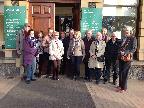History
ABOUT THIS GROUP
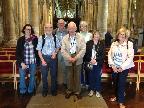 | Aim of the group is to enjoy History by exploring a variety of historical topics. To foster a collaborative and supportive approach in the group. To take a particular interest in the History on our doorstep. The group aim to explore topics in different ways, for example: do our own research; share knowledge and ideas in the group; enlist the help of people with specialist knowledge; visit places of historical interest | Meet 2nd Wednesday Each Month 1pm-3pm at a variety of outdoor locations | Please contact Convenors for more Information, | Genise Green History Group Convenor 1 |
Safeguarding Garforth Historical Society Archive 5th February 2024
 |  |  |
In February, the History Group enjoyed looking through some of the many items stored in the Local History section of Garforth Library. Our fellow U3A member, Tony Robinson, introduced the session and then along with History Group member, Carol Jinks, they introduced us to the many photographs, maps, newspaper cuttings, graveyard and census records which had been laid out for us all to view. It was explained that what we saw was only a fraction of what the library contains on the local history of Garforth and the surrounding area.
We were able to see how Garforth Main Street (or Briggate as it used to be called) looked before cars took precedence over people. We tracked the locations of mining tunnels and the old sand quarry (perhaps best not to know!). And we viewed a very detailed study of every grave in St Mary's churchyard, including photos and transcripts of the memorials - a project which must have taken many months work by a dedicated local historian. It was a treasure trove of information for us all and one attendee even came across information in the collection about their own relatives.
Visit to Kirkgate Market, 11th Oct 2023
 |  |
In October the History Group took a Heritage Tour of Leeds Kirkgate Market. Said to be the largest covered market in Europe, this Grade I listed structure currently hosts 245 businesses across the indoor and outdoor markets and averages about 138,000 visitors per week. Kirkgate Market has been on this site in its current form for 120 years but the first open air markets began here in 1822.
Construction of Kirkgate Market itself began in 1857 with further developments in 1875. When Leeds was granted city status in 1893 the area boomed and there was a desire for grand civic buildings. The area around the market needed some gentrification, surrounded as it was by slums and abattoirs. A design competition led to the building of the ornate 1904 hall.
MandS originated in Kirkgate Market in 1884 with their Penny Bazaar and in 1984, the MandS Centenary Clock was unveiled in the 1904 market hall to mark the anniversary. The original market clock on the same spot was removed in 1912 as it took up too much room - it is now known as the Oakwood Clock!
Fire rampaged through two thirds of the market in December 1975 but thankfully the 1904 hall was undamaged and reopened only three days later. The market has continued to evolve, surviving fire, supermarkets, new shopping centres, and covid. We finished our visit with a wonderful view from the balcony, which is not usually open to the public.
Visit to Markenfield Hall, Ripon 16th Aug 2023
 |  |  |
 In August the History Group made a long anticipated visit to Markenfield Hall near Ripon. This very pretty medieval manor house is surrounded by a moat and is set in 600 acres of farmland.
In August the History Group made a long anticipated visit to Markenfield Hall near Ripon. This very pretty medieval manor house is surrounded by a moat and is set in 600 acres of farmland.
The first building on site appeared in 1230 as a 3 up 3 down stone structure with vaulted ceilings at ground floor level. Crenellations were added by Canon John de Markenfield in 1310 by permission of the Crown, giving it the look of a mini castle.
There were many extensions and alterations to the Hall over the next few centuries but sadly little is known about their history. This may be due to the staunchly Catholic Sir Thomas Markenfield's act of high treason in taking part in the Rising of the North in 1569, which supported placing Mary Queen of Scots on the English throne. As a result of this failed action, Elizabeth I swiftly confiscated the Hall and subsequently all the family papers were lost. Sir Thomas was lucky to escape a traitors death of being hanged, drawn and quartered by fleeing abroad but he died alone and in poverty in 1592.
In 1761 Sir Thomas Fletcher Norton, a direct descendant of the Markenfield family, bought the neglected house for £9,400. His most unusual renovation (to avoid spoiling the look of the house with downpipes) was an internal gutter system which collects water from the roof, runs right across the living room ceiling and shoots through the wall directly into the moat in an arcing flow! He later became Lord Grantley, First Baron of Markenfield, a title still held by the family and Lady Deirdre still lives at the Hall today.
We finished our visit with tea and cakes and decided that Markenfield Hall certainly lived up to its own marketing literature, which describes it as 'the loveliest place you've never heard of'
Visit to Sandal Castle 13th July 2023
Continuing with our Battlefield theme this Summer, the History Group visited Sandal
 |  |
.
A blustery but thankfully dry morning found us taking a guided tour of the site, provided by Kevin and Alan who run their own website for both Pontefract and Sandal Castle. We heard a very comprehensive history of the site, it's owners and it's most famous role - at the Battle of Wakefield in December 1460.
The first and original timber built 11th Century Sandal Castle was a short distance away from the current one. However it was obvious why William de Warenne, owner of the Manor of Wakefield, chose to move it's location as the 'new' stone built castle, likely completed in the 13th Century, stands on the highest point in the area, commanding extensive views in all directions which is very handy when you want to keep your enemies at bay! The Castle was particularly difficult to storm, with a deep dry moat, an entrance route set on an angle and a total height of 83 feet from top to bottom.
Sandal's major claim to fame was it's role in the Battle of Wakefield in December 1460, which formed part of the Wars of the Roses. The battle was fought on Wakefield Green just below the Castle and the Duke of York was mortally wounded, ending in a resounding Lancastrian victory. The place where he fell is marked a few hundred metres from the Castle.
Apart from a very short lived revival during the Civil War, the Castle has been left to decay for many centuries, with it's defences eventually stripped and much of the stonework robbed for other purposes. One now needs some imagination to picture the Castle in its glory, but the site (and the on site cafe) were enjoyed by us all.
Visit to Towton Battlefield 14th June 2023
 |  |  |
The History Group enjoyed a visit to the Towton Battlefield Visitor Information Centre and the battle site in June. A talk by Chris Berendt, Chairman of the Battlefield Society, explained how the armies of two disputed Kings of England fought all day in a freezing snowstorm on Palm Sunday, 29 March 1461.
The two rival Kings were Henry VI of the House of Lancaster and Edward IV of the House of York. Considered to be the bloodiest battle on English soil, 75,000 men fought that day but eventually the Yorkists emerged victorious. Allegedly 28,000 men from both sides lay dead on the battlefield, though this figure has been disputed by more recent historians.
The bloody battle and extraordinarily high death rate was attributed partly to the killing power of the medieval longbow. Trained from the age of 7, a longbowman could shoot an arrow from a 160lb pull longbow every ten seconds. If you survived the arrows then close quarters damage would be done by soldiers carrying a bill hook, poleaxe, sword or mace - all of which we saw in replica and they all looked horrific! In the end the Lancastrians were overwhelmed by the enemy, the terrain and no doubt the attrocious weather. They had to make a run for it but they didn't get far in their heavy, wet, woollen clothing or their cumbersome armour (only for the very rich of course).
The Yorkist victory set England on the road to a Tudor dynasty, but that's a whole other story...
Visit to Templenewsam -Object Handling 19th April 2023
 |  |  |
Templenewsam Object Handling Click for Report
Visit To Hazelwood Castle and St Leonards Church 20th Feb 2023
 .. ..  |  |
A dull rainy morning in March found the Group taking a History Tour of Hazlewood Castle and St Leonard's Church and what a lot of history there was! The first records of the house are to be found in the Domesday Book, described as being owned and occupied by Sir Mauger the Vavasour (a vavasour was a type of feudal liegeman). Hazlewood was then inhabited by descendants of the Vavasours for over 900 years.
In 1217 Robert Vavasour was Sheriff of York and his statue was placed above the door of York Minster, holding a block of limestone, in recognition of the fact that he gave stone from his Tadcaster quarry to maintain the cathedral. You can still see him there today.
Hazlewood is one of the oldest fortified houses to survive in the whole of Yorkshire and is Grade I listed. The site overlooked the battlefield for the Battle of Towton in 1461 and during the persecution of the Catholics through the reign of Henry VIII it provided refuge for Catholic priests. It is apparently to Anne Vavasour, Maid of Honour to Elizabeth I, that we must be thankful for Hazlewood surviving the reformation. Anne was able to use her influence at Court to save her Catholic family home from destruction.
The house continued to be owned and lived in by the Vavasours and underwent many alterations through subsequent centuries until eventually death duties took their toll and the Castle was sold in 1908. The Vavasours moved to New Zealand to become sheep farmers and wine producers!
After 1908 the site changed hands several times over the following years. Some people will know that Hazlewood was a Maternity Hospital during WW2 until 1953. One of our tour group was actually born there so he was able to revisit his own delivery room! More people may recall that Hazlewood was a retreat for Carmelite Friars between 1971 and 1997, after which it became a rather posh hotel which now makes its money by hosting weddings.
York Visit March 2022
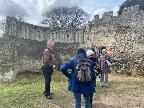 |  | 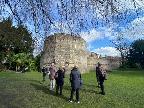 | 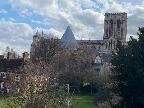 |
Report On Kippax Coalmining Exhibition Nov 2021
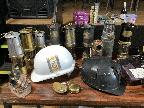 | 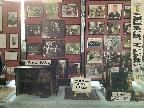 |
Report on the Kippax History Walk Oct 2021
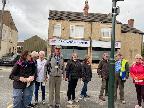 .. .. 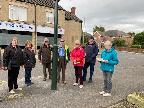 | 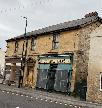 |
Report on the Zoom Meeting Templenewsam June 2021
Report on a walk to see sites relating to the Mine Disaster
Peckfield Mining Disaster Walk
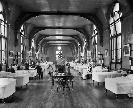 Florence Nightingale Talk
Florence Nightingale Talk
At the zoom meeting in November Stephanie Davies gave a talk on Florence's connection with Leeds General Infirmary and Lotherton Hall}
Lockdown Miscellany June 2020
During the Coronavirus Lockdown the usual meetings and visits of the History Group were suspended. This Miscellany arose out of Zoom and email exchanges when members were sharing thoughts about local features of interest. Additional relevant information about the topics was found online. Click the link Lockdown Miscellany
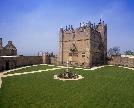 Visit to Bolsover Castle 26th Feb 2020
Visit to Bolsover Castle 26th Feb 2020
Bolsover Castle Information
January 2020 Update.
We had our January meeting in the local history section of Garforth Library looking at the books and other material such as old maps and photographs. If you are interested in local history it is well worth checking this out.
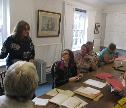 On Wednesday 21st Aug 2019 The U3A history Group visited Lotherton Hall, the last home of the Gascoigne family, We saw an exhibition dedicated to Captain Douglas Gascoigne (Coldstream Guards) the last son and heir of the Gascoigne family. Douglas was part of the 1944 WW2 battle to take Normandy and was killed in a tank battle near Caen on 6th August just two months after the D day landings.
On Wednesday 21st Aug 2019 The U3A history Group visited Lotherton Hall, the last home of the Gascoigne family, We saw an exhibition dedicated to Captain Douglas Gascoigne (Coldstream Guards) the last son and heir of the Gascoigne family. Douglas was part of the 1944 WW2 battle to take Normandy and was killed in a tank battle near Caen on 6th August just two months after the D day landings.
The main purpose of the History Group visit was to view the archives which document the history of the Gascoigne family.The photograph shows members of the history group together with Stephanie Davies, the Assistant Curator at Lotherton Hall.
 Sir John Gascoigne, the first Baronet. He purchased the title in 1635 at a cost equivalent to £5m in today's money. The title was conferred by Charles 1. The money went into a fund for developing the North American colonies.
Sir John Gascoigne, the first Baronet. He purchased the title in 1635 at a cost equivalent to £5m in today's money. The title was conferred by Charles 1. The money went into a fund for developing the North American colonies.
 Sir Thomas Gascoigne, the eighth and last Baronet, as a man of the Enlightenment. He inherited the title in 1762. Later he gave up his Catholic faith. This meant he could take a more active role in public life, including becoming an MP. In October 1809 Sir Thomas' son and heir died in a hunting accident. This was a great personal blow for Sir Thomas and he only outlived his son by four months. With no heir the Baronetcy lapsed.
Sir Thomas Gascoigne, the eighth and last Baronet, as a man of the Enlightenment. He inherited the title in 1762. Later he gave up his Catholic faith. This meant he could take a more active role in public life, including becoming an MP. In October 1809 Sir Thomas' son and heir died in a hunting accident. This was a great personal blow for Sir Thomas and he only outlived his son by four months. With no heir the Baronetcy lapsed.
On 10th July 2019 the Group paid a visit to Selby Abbey, enjoyed a full guided tour and learnt about the Abbey's history including the connection between the Abbey and important historical events. For the full report click the link Selby Abbey Report
Click on a picture below to see it full-size with more details.
















